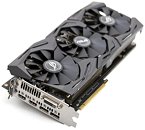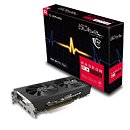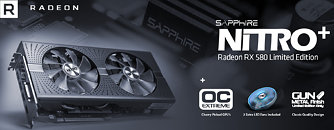Raevenlord
News Editor
- Joined
- Aug 12, 2016
- Messages
- 3,755 (1.23/day)
- Location
- Portugal
| System Name | The Ryzening |
|---|---|
| Processor | AMD Ryzen 9 5900X |
| Motherboard | MSI X570 MAG TOMAHAWK |
| Cooling | Lian Li Galahad 360mm AIO |
| Memory | 32 GB G.Skill Trident Z F4-3733 (4x 8 GB) |
| Video Card(s) | Gigabyte RTX 3070 Ti |
| Storage | Boot: Transcend MTE220S 2TB, Kintson A2000 1TB, Seagate Firewolf Pro 14 TB |
| Display(s) | Acer Nitro VG270UP (1440p 144 Hz IPS) |
| Case | Lian Li O11DX Dynamic White |
| Audio Device(s) | iFi Audio Zen DAC |
| Power Supply | Seasonic Focus+ 750 W |
| Mouse | Cooler Master Masterkeys Lite L |
| Keyboard | Cooler Master Masterkeys Lite L |
| Software | Windows 10 x64 |
The floodgates have opened on AMD's recently-launched RX 500 series, which features a more polished, revised, 3rd-gen 14 nm FinFet process. Graphics cards based on the new GPUs will, as such, feature higher clocks than their RX 400 series counterparts, even if the number of graphics processing resources remains relatively unchanged. PowerColor (with its Red Devil and Red Dragon RX 580 and RX 570 graphics cards), ASUS, Sapphire, Gigabyte, and MSI have all announced their take on the new GPUs, with distinct enterprise identity, cooling solutions and audio profiles - as well as VRM and power delivery subsystems - competing for your money.



First up, we have the ASUS line-up, which currently comes in at three varieties: the RX 570 STRIX 4 GB ($179) and the RX 570 STRIX OC 4 GB ($189), which make do with the same dual-fan cooling solution but slightly higher clocks on the OC version. A little higher in the price bracket than these we find ASUS' RX 580 STRIX, which features a triple-fan, triple-slot cooling solution with RGB details, which should sell at the $269-$279 point.




Next up, Sapphire has announced has many as eight models covering the RX 570 and RX 580 graphics cards: the Pulse editions seem to be a slightly less expensive foray into the RX 500 series, with the RX 570 Pulse 4GB (1284 MHZ) going for $169 against the RX 570 Nitro+ 4GB's $199 price-tag (1340 MHz), and the RX 580 Pulse 8GB (1366 MHz) costing $20 less than the RX 580 Nitro+ 8GB's $249 (1411 MHz), at $229. Rounding out these price points, we have the 4GB RX 580 Pulse (1366 MHz), for $209, and Sapphire's prodigy child, the RX 580 Nitro+ Limited Edition 8GB ($275, 1450 MHz), which comes with an extra pair of blue-lighted fans that you can swap in, and comes with what Sapphire says are cherry-picked dies to ensure maximum overclocking ability. Also interesting is the SAPPHIRE PULSE ITX RX 570 4GB, though, which, as the name implies, is designed for ITX systems, with its graphics chip running at 1244 MHz and sipping power from a single 6-pin power connection.









View at TechPowerUp Main Site



First up, we have the ASUS line-up, which currently comes in at three varieties: the RX 570 STRIX 4 GB ($179) and the RX 570 STRIX OC 4 GB ($189), which make do with the same dual-fan cooling solution but slightly higher clocks on the OC version. A little higher in the price bracket than these we find ASUS' RX 580 STRIX, which features a triple-fan, triple-slot cooling solution with RGB details, which should sell at the $269-$279 point.




Next up, Sapphire has announced has many as eight models covering the RX 570 and RX 580 graphics cards: the Pulse editions seem to be a slightly less expensive foray into the RX 500 series, with the RX 570 Pulse 4GB (1284 MHZ) going for $169 against the RX 570 Nitro+ 4GB's $199 price-tag (1340 MHz), and the RX 580 Pulse 8GB (1366 MHz) costing $20 less than the RX 580 Nitro+ 8GB's $249 (1411 MHz), at $229. Rounding out these price points, we have the 4GB RX 580 Pulse (1366 MHz), for $209, and Sapphire's prodigy child, the RX 580 Nitro+ Limited Edition 8GB ($275, 1450 MHz), which comes with an extra pair of blue-lighted fans that you can swap in, and comes with what Sapphire says are cherry-picked dies to ensure maximum overclocking ability. Also interesting is the SAPPHIRE PULSE ITX RX 570 4GB, though, which, as the name implies, is designed for ITX systems, with its graphics chip running at 1244 MHz and sipping power from a single 6-pin power connection.









View at TechPowerUp Main Site

